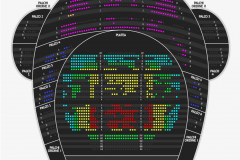Romeo and Juliet
Mo | Tu | We | Th | Fr | Sa | Su |
The Monegasque ensemble will perform the famous ballet inspired by William Shakespeare's tragedy, in the production – presented for the first time at the Monte-Carlo Opera in 1996 – which uses sets by Ernest Pignon-Ernest, costumes by Jérôme Kaplan and lighting design by Dominique Drillot.
Starting from the idea that everyone knows the story of Romeo and Juliet, Jean-Cristophe Maillot has adopted a choreographic perspective that avoids paraphrasing Shakespeare's literary monument: rather than following step by step the dispute between Capulets and Montagues until its tragic epilogue, the choreographer revisits the tragedy following an original point of view. The ballet transports us into the tormented soul of Friar Laurence, who, wanting to do good, ultimately causes the death of the two lovers. Romeo and Juliet by Jean-Christophe Maillot is the flashback of this shocked religious man who, at the end of the drama, wonders how it could have come to this. This starting point enlightens us on the sensitivity of the choreographer, who interprets the story narrated in the Shakespearean tragedy not as a social conflict or a fight between clans regulated by a code of honor, but on the contrary as a fortuitous drama that causes the death of two boys more taken by the games of love than by those of hate.
A choreography that upsets the codes of classical dance in what is most traditional, while at the same time preserving its momentum, energy and timeless grace. Romeo and Juliet is a cornerstone of Maillot's repertoire: a classical vocabulary with a contemporary syntax always at the crossroads of multiple artistic disciplines.
Program and cast
ARTISTS
Conductor: Garrett Keast
Choreography: Jean-Christophe Maillott
Sets: Ernest Pignon-Ernest
Costumes: Jérôme Kaplan
Lights: Dominique Drillot
Les Ballets de Monte-Carlo
Maggio Musicale Fiorentino Orchestra
Teatro del Maggio Florence State Opera Italy
Teatro del Maggio is in the centre, close to the old city walls, next to the historic Stazione Leopolda. The garden that welcomes visitors is Piazzale Vittorio Gui, named after the founder of the Stabile Orchestrale Fiorentina and the Maggio Musicale Fiorentino.
By train
Santa Maria Novella is Florence's main train station.
From there you can reach the theatre with a short walk (about 10-15 minutes) or by taking the tram (a stop) or a taxi.
By car
The Opera di Firenze is just outside the ZTL area.
It is possible to park near the Parco delle Cascine or for a fee in the Porta al Prato car park (Via Elio Gabbuggiani, 7) and in the Piazza Vittorio Veneto car park.
By bus
Lines C1, C2 and D (Leopolda stop);
Lines 17 and 23A-B (stop Via delle Carra);
Lines 17B-C, 22, 23N, 23 and 57 (Pierluigi da Palestrina stop);
Lines 29, 29B, 29BA, 29BC, 29D, 30A, 30B, 30AC, 35 and 35° (stop Leopolda - Porta al Prato; Capolinea).
By tram
Line T1 (stop Porta al Prato - Parco della musica).

 EN
EN DE
DE IT
IT FR
FR ES
ES RU
RU JP
JP RO
RO
 Seating plan
Seating plan 